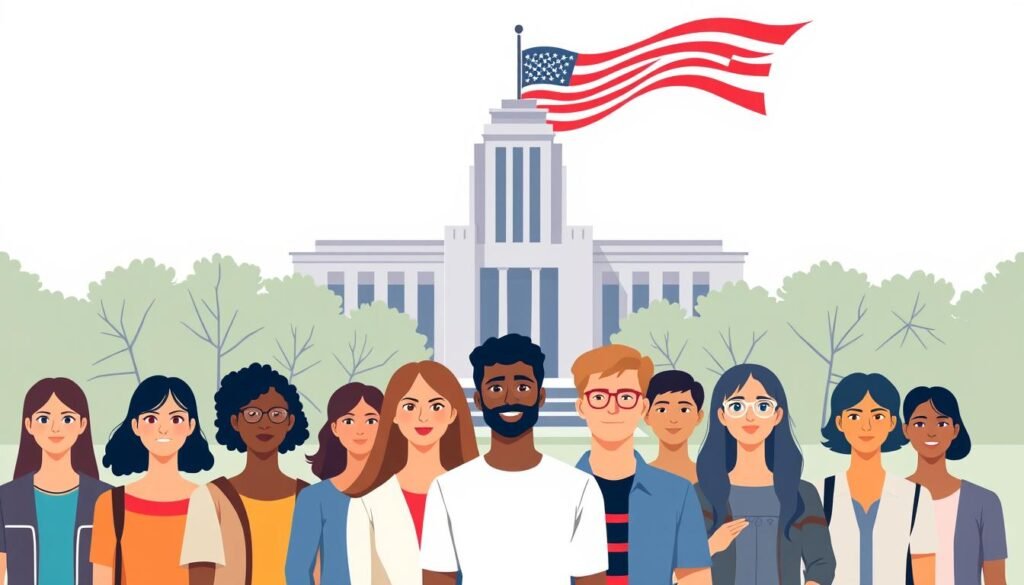
Federal student loans USA 2026: Your Path to Financial Aid

You may feel nervous about how to pay college, but a clear plan can change that. Imagine opening an award letter and seeing a mix of grant aid, work-study, and a loan option that actually makes sense. That moment turned a worry into a workable plan for one recent grad I met.
In that story, simple steps mattered: she filed the FAFSA, checked different types of aid, and picked a loan with fixed interest rates and flexible repayment options. Small choices gave her breathing room and time to focus on classwork.
In this guide you’ll get a friendly roadmap to federal student loans, learn how student aid flows from application to offer, and see which repayment options match your goals. You’ll leave ready to act with confidence and fewer surprises.
- Start here: Your beginner’s guide to federal student loans in the United States
- What a federal student loan is and how it works
- Types of federal student loans explained
- Eligibility basics: who can receive federal student loans
- How to apply: FAFSA to funding in clear steps
- Federal student loan limits and cost of attendance
- Interest, in-school status, deferment, and your six‑month grace
- Repayment options that fit your budget
- Why federal loans first: key benefits versus private student loans
- Your next steps to succeed with federal student loans USA
Start here: Your beginner’s guide to federal student loans in the United States
This short primer explains the steps that take you from application to money in your school account. File the FAFSA online and expect processing in about 3–5 days (or 7–10 by mail). Schools use that data to build a financial aid offer that may include grants, work‑study, and loans.
If you accept borrowing: you must complete entrance counseling and sign a Master Promissory Note on studentaid.gov before funds are disbursed. Repayment usually begins after a six‑month grace period once you leave school or graduate.

"Complete the FAFSA early, compare offers, and borrow only what you need."
Use this quick checklist to move forward:
- Submit FAFSA, then review your award letter carefully.
- Accept only the amount that fills your gap after grants and scholarships.
- Finish counseling and sign the note on studentaid.gov.
- Track repayment plans to find fixed or income‑driven options that fit your budget.
| Loan Type | Who | Key feature |
|---|---|---|
| Direct Subsidized | Undergraduates | Government pays interest while you’re in school |
| Direct Unsubsidized | Undergrad & grad | Interest accrues during school |
| PLUS | Parents & grads | Credit check required; covers up to cost of attendance |
What a federal student loan is and how it works
This section explains how aid is calculated, delivered, and used so you borrow only what you need.
How aid is set: Your school uses FAFSA data and its published cost attendance to calculate eligible funding. That number shows how much you can receive for approved education costs.

How federal student aid helps you pay for college
Grants and work‑study come first because they do not require repayment. Loans fill the remaining gap so you can cover bills without cutting classes.
Need‑based and non‑need‑based options differ. Schools list each on your award notice, so compare total cost and the interest rate before you accept any funds.
What you can use loans for
You may apply funds to tuition, fees, books, supplies, and room and board. Use only the amount needed for legitimate educational expenses to avoid unnecessary debt.
Direct Subsidized helps undergraduates by pausing interest while you’re enrolled at least half‑time and during the six‑month grace after you leave school.
Direct Unsubsidized and other unsubsidized loans accrue interest from disbursement; unpaid interest can capitalize and increase what you owe. Know how that affects lifetime cost and plan to make payments if possible while enrolled.
"Borrow what you need, track disbursements, and plan for repayment early."
- Check how your award mixes grants, work‑study, and loans.
- Track disbursements to ensure funds go to approved costs.
- Start planning to make payments after the six‑month grace ends; learn about the loan repayment system loan repayment system.
- Explore scholarships before borrowing by reviewing guides like this undergraduate scholarships guide.
Types of federal student loans explained
Understanding the main options makes choosing easier when your award arrives. Below are the different types you’ll commonly see and how each affects cost and eligibility.

Direct Subsidized Loans: need-based help
Direct Subsidized Loans serve undergraduates with demonstrated need. No interest is charged while you’re enrolled at least half‑time, in deferment, or during the six‑month grace period.
Direct Unsubsidized Loans: broader access
Direct Unsubsidized Loans are not need‑based and are available to both undergrad and graduate students. Interest accrues from disbursement; unpaid interest may capitalize and raise what you owe.
Direct PLUS Loans: Parent PLUS and Grad PLUS
PLUS loans help parents of dependents and graduate borrowers cover remaining cost attendance gaps. These loans are not based on need but do require a credit check. If an adverse credit history appears, you’ll need to meet extra requirements to qualify.
"Compare rates, fees, and how interest behaves before you accept any funds."
- Decide between subsidized and unsubsidized based on FAFSA results and academic level.
- Consider PLUS only after grants and other aid, since it can cover up to cost attendance minus other awards.
- Prepare documentation for a credit history review if you apply for PLUS.
Eligibility basics: who can receive federal student loans
Eligibility determines whether you can get aid; learning the key requirements saves time and surprises.
Core checks: you must be a U.S. citizen or eligible noncitizen, have a valid Social Security number, and hold a high school diploma or equivalent. You must also be admitted to an eligible degree or certificate program to receive federal student aid.
Enrollment and academic progress
You usually must be enrolled at least half‑time to get funds each term. Schools require you to meet satisfactory academic progress to keep access to awards.
If you drop below half‑time or fall out of good standing, disbursements can stop and repayment rules may change.
When credit checks apply
PLUS applications trigger a credit check. An adverse credit history can require a cosigner or documentation of extenuating circumstances.
Keep records handy: verification forms, enrollment proofs, and updated contact details help your servicer resolve issues quickly.
"File the FAFSA each year you plan to attend to receive federal consideration and to keep benefits active."
How to apply: FAFSA to funding in clear steps
Start with the official, no-cost form and follow a short sequence to move from application to funds.
Begin online: file the free application federal on studentaid.gov. With documents at hand, the free application takes most people under an hour. Online submissions usually process in about 3–5 days; paper takes roughly 7–10 days.
What happens after you submit
You’ll get a FAFSA Submission Summary. Schools listed on your form use that data to create a financial aid offer. The offer may include grants, work‑study, and loans. Compare items carefully before deciding.
Accepting aid and next steps
To accept borrowing, complete entrance counseling and sign the Master Promissory Note on studentaid.gov. Parents and grad borrowers who seek plus loans file a separate application and face a credit check.
"File early, accept only what you need, and finish the MPN and counseling so funds can disburse."
- Choose amounts conservatively and decline unneeded funds.
- Confirm enrollment status so you receive federal disbursements on time.
- Keep records and update your FAFSA if corrections are needed.
- Consider making payments while enrolled to reduce interest on unsubsidized balances.
Federal student loan limits and cost of attendance
Start by learning how your school's cost of attendance sets the ceiling for aid. Schools subtract grants, scholarships, and work‑study from the published cost attendance to show how much borrowing remains. That gap is your available borrowing room.
Dependent vs. independent undergraduate caps
Annual and lifetime limits differ by status. Dependent undergraduates face lower aggregate caps—typically up to $31,000 total, with no more than $23,000 in subsidized loans.
Independent undergrads or those whose parents can’t get PLUS may borrow up to about $57,500 in aggregate, still capped at $23,000 subsidized.
Graduate totals and PLUS coverage
Graduate and professional borrowers have higher lifetime maximums around $138,500 total, including no more than $65,500 subsidized. PLUS loans for parents or graduate students can cover up to the school's cost attendance after other aid is applied.
"Track how subsidized and unsubsidized amounts show on your award so you protect eligibility and limit interest."
- Use a quick worksheet: cost attendance free aid = gap to cover.
- Borrow conservatively now to preserve future eligibility and lower long‑term interest.
Interest, in-school status, deferment, and your six‑month grace
Understand how interest behaves while you study and during the brief pause after you leave school. Knowing this helps you plan payments and protect your balance from surprises.
Direct subsidized loans do not accrue interest while you’re enrolled at least half‑time, during approved deferments, or through the six‑month grace after you leave school. That pause saves money and reduces compounded costs.
Direct unsubsidized loans accrue interest at all times. Unpaid interest grows daily and can capitalize when repayment starts. Capitalization raises your principal and increases what you pay over the life of the loan.
- Make interest‑only payments while enrolled or in grace to avoid capitalization spikes.
- Target higher interest balances first to lower lifetime cost.
- Check your servicer account for exact interest rate and payoff amounts before you leave school.
"Paying small amounts now can cut years off your balance and save real money."
When the six‑month grace ends, you must start repayment. Use these steps in the months after you graduate to be ready and to keep your federal student borrowing under control.
Repayment options that fit your budget
Your monthly payment should fit your budget, not the other way around start by reviewing plan types.
Fixed plans set predictable timetables. Standard repayment pays a set amount each month until the balance clears. Graduated starts lower and rises, which can help early-career borrowers. Extended gives longer terms for lower monthly bills but increases total interest paid.
Income-driven choices
Plans like SAVE, PAYE, IBR, and ICR set payments based on your income and family size. These repayment options tie monthly payments to earnings and can lead to forgiveness after qualifying years.
Forgiveness paths
Public Service Loan Forgiveness (PSLF) forgives balances for qualifying public work after meeting payments and documentation rules. IDR forgiveness cancels remaining balances after a required payment period and annual recertification.
- Compare repayment plans that set predictable amounts with those that set payments based on income.
- Consider consolidating to simplify billing or to access certain plans.
- Target unpaid interest on unsubsidized loans and direct subsidized balances where possible to save long term.
- Enroll or switch plans via your servicer portal and confirm details in writing; use auto‑debit and reminders to avoid missed payments.
"Choose the plan that fits your cash flow today and your goals for tomorrow."
Why federal loans first: key benefits versus private student loans
Compare core protections before you borrow. Start with options that give predictable fixed interest and built‑in safety nets. Those features often reduce long‑term cost and risk compared with many private lenders.
Key advantages: access to income‑driven repayment plans, deferment and forbearance options, and forgiveness paths such as PSLF and long‑term IDR. You can switch repayment plans after disbursement to match changing income.
Most public programs do not require a cosigner or an established credit history. That contrasts sharply with many private products. Note one exception: PLUS loans require a credit check.
"Start with public options to preserve protections that private lenders rarely match."
- Stable interest rate setting and standardized terms reduce surprises.
- Income-based repayment can lower monthly bills when earnings are low.
- Forgiveness programs may cut total repayment for qualifying careers.
- Private lenders may price offers on credit history and current market rates.
| Feature | Public programs | Private lenders | When private may help |
|---|---|---|---|
| Interest rate | Generally fixed and disclosed | Often variable or credit-based | When you have excellent credit and need extra funds |
| Repayment plans | Multiple income-driven and standard choices | Limited options; fewer protections | If you need lower fees or co-signer terms |
| Credit check | Not required for most, except PLUS | Usually required; may need cosigner | If you have strong credit and want a lower rate |
| Forgiveness & safety nets | PSLF, IDR forgiveness, deferment/forbearance | Rare or none | Private refinance after maxing public benefits |
Your next steps to succeed with federal student loans USA
Finish strong: file the FAFSA early and apply federal student aid by listing each school you’re considering. The faster you file the free application federal, the sooner schools can send offers and you can receive federal aid.
Carefully review each award and accept only what you need. Complete entrance counseling and sign your Master Promissory Note on studentaid.gov so disbursements aren’t delayed. If you or a parent wants plus loans, file the separate application and plan for the credit check timeline.
You usually have a six‑month grace after you graduate or drop below half‑time. Use those months graduate to choose repayment options and set up your servicer account.
Start practical habits: enroll in auto‑debit, make payments early where possible to cut interest, and keep one folder with your FAFSA summary, award letters, MPN, and servicer messages. This simple routine keeps your borrowing and repayment on track.
If you want to know other articles similar to Federal student loans USA 2026: Your Path to Financial Aid you can visit the category Federal.




Leave a Reply